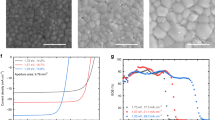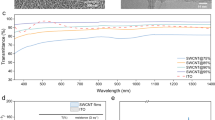Abstract
Simultaneously achieving high voltage and high efficiency in thin-film solar cells is of paramount importance for real-world applications. While solar cells fabricated from the Earth-abundant kesterite absorber Cu2ZnSn(S x Se1−x )4 provide an attractive, non-toxic, energy harvesting solution, their utilization has been constrained by relatively low open-circuit voltages that limit efficiency. Increasing the sulfur content to widen the bandgap boosts the voltage, but usually at the expense of efficiency. Here, we report important progress on this fundamental problem by fabricating solar cells with high sulfur content that exhibit efficiencies up to 11.89% with open-circuit voltages as high as 670 mV. In a multistep process, fully functional solar cells are separated from their growth substrate, and a high-work-function back contact is subsequently deposited. With this approach, we fabricated a series-connected device that produces 5.7 V under 1 Sun illumination and ~2 V under low lighting conditions, below 10−3 Suns.
This is a preview of subscription content, access via your institution
Access options
Access Nature and 54 other Nature Portfolio journals
Get Nature+, our best-value online-access subscription
$29.99 / 30 days
cancel any time
Subscribe to this journal
Receive 12 digital issues and online access to articles
$119.00 per year
only $9.92 per issue
Buy this article
- Purchase on Springer Link
- Instant access to full article PDF
Prices may be subject to local taxes which are calculated during checkout






Similar content being viewed by others
References
Haight, R., Haensch, W. & Friedman, D. Solar-powering the Internet of Things. Science 353, 124–125 (2016).
Zhai, B. et al. Energy-efficient subthreshold processor design. IEEE Trans. Very Large Scale Integr. Syst. 17, 1127–1137 (2009).
Wang, W. et al. Device characteristics of CZTSSe thin-film solar cells with 12.6% efficiency. Adv. Energy Mater. 4, 1–5 (2014).
Green, M. A., Emery, K., Hishikawa, Y., Warta, W. & Dunlop, E. D. Solar cell efficiency tables (version 48). Prog. Photovolt. Res. Appl. 24, 905–913 (2016).
Shockley, W. & Queisser, H. J. Detailed balance limit of efficiency of p–n junction solar cells. J. Appl. Phys. 32, 510–519 (1961).
Shin, B. et al. Thin film solar cell with 8.4% power conversion efficiency using an earth‐abundant Cu2ZnSnS4 absorber. Prog. Photovolt. Res. Appl. 21, 72–76 (2013).
Sun, K. et al. Over 9% efficient kesterite Cu2ZnSnS4 solar cell fabricated by using Zn1–x Cd x S buffer layer. Adv. Energy Mater. 6, 1600046 (2016).
Chen, S., Walsh, A., Gong, X. G. & Wei, S. H. Classification of lattice defects in the kesterite Cu2ZnSnS4 and Cu2ZnSnSe4 earth-abundant solar cell absorbers. Adv. Mater. 25, 1522–1539 (2013).
Green, M. A. et al. Prog. Photovolt. Res. Appl. 25, 668–676 (2017).
Tai, K. F. et al. Fill factor losses in Cu2ZnSn (S x Se1−x )4 solar cells: insights from physical and electrical characterization of devices and exfoliated films. Adv. Energy Mater. 6, 1501609 (2016).
Barkhouse, D. A. R., Gunawan, O., Gokmen, T., Todorov, T. K. & Mitzi, D. B. Device characteristics of a 10.1% hydrazine‐processed Cu2ZnSn(Se,S)4 solar cell. Prog. Photovolt. Res. Appl. 20, 6–11 (2012).
Todorov, T. K. et al. Beyond 11% efficiency: characteristics of state‐of‐the‐art Cu2ZnSn(S,Se)4 solar cells. Adv. Energy Mater. 3, 34–38 (2013).
Haight, R., Shao, X., Wang, W. & Mitzi, D. B. Electronic and elemental properties of the Cu2ZnSn(S,Se)4 surface and grain boundaries. Appl. Phys. Lett. 104, 033902 (2014).
Sardashti, K. et al. Impact of nanoscale elemental distribution in high-performance kesterite solar cells. Adv. Energy Mater. 5, 1–9 (2015).
Scragg, J. J. S., Choubrac, L., Lafond, A., Ericson, T. & Platzer-Bjoerkman, C. A low-temperature order-disorder transition in Cu2ZnSnS4 thin films. Appl. Phys. Lett. 104, 1–5 (2014).
Haight, R. et al. Band alignment at the Cu2ZnSn(S x Se1–x )4/CdS interface. Appl. Phys. Lett. 98, 253502 (2011).
Gershon, T., Bishop, D., McCandless, B., Wang, W. & Haight, R. Capturing the effect of long low-temperature anneals on the sub-band-gap defect structure of CZTSSe. In Proc. SPIE 9552: Carbon Nanotubes, Graphene and Emerging 2D Materials for Electronic and Photonic Devices VIII (eds. Razegli, M. et al.) 955209-1-6 (International Society for Optics and Photonics, 2015).
Lee, J.-H., Yi, J.-S., Yang, K.-J., Park, J.-H. & Oh, R.-D. Electrical and optical properties of boron doped CdS thin films prepared by chemical bath deposition. T hin Solid Films 431, 344–348(2003).
Cozza, D., Ruiz, C. M., Duché, D., Simon, J. J. & Escoubas, L. Modeling the back contact of Cu2ZnSnSe4 solar cells. IEEE J. Photovoltaics 6, 1292–1297 (2016).
Shin, B., Zhu, Y., Bojarczuk, N. A., Jay Chey, S. & Guha, S. Control of an interfacial MoSe2 layer in Cu2ZnSnSe4 thin film solar cells: 8.9% power conversion efficiency with a TiN diffusion barrier. Appl. Phys. Lett. 101, 53903 (2012).
Oueslati, S. et al. Study of alternative back contacts for thin film Cu2ZnSnSe4-based solar cells. J. Phys. D 48, 35103 (2014).
Lee, Y. S. et al. CZTSe thin-film solar cells by thermal co-evaporation with 11.6% efficiency and improved minority carrier diffusion length. Adv. Energy Mater. 5, 2–5 (2015).
Antunez, P. D. et al. Back contact engineering for increased performance in kesterite solar cells. Adv. Energy Mater. 7, 1602585 (2017).
Sardashti, K. et al. Nanoscale characterization of back surfaces and interfaces in thin-film kesterite solar cells. ACS Appl. Mater. Interfaces 9, 17024–17033 (2017).
Irfan et al. Energy level evolution of air and oxygen exposed molybdenum trioxide films. Appl. Phys. Lett. 96, 20–23 (2010).
Liu, Y., Sun, Y. & Rockett, A. A new simulation software of solar cells—wxAMPS. Sol. Energy Mater. Sol. Cells 98, 124–128 (2012).
Green, M. A. et al. Solar cell efficiency tables (version 49). Prog. Photovolt. Res. Appl. 25, 3–13, https://doi.org/10.1002/pip2855 (2017).
Rühle, K., Glunz, S. W. & Kasemann, M. Towards new design rules for indoor photovoltaic cells. In Proc. 38th IEEE Photovoltaic Specialists Conf., 2588–2591 (IEEE, 2012).
Apostolou, G., Reinders, A. & Verwaal, M. Comparison of the indoor performance of 12 commercial PV products by a simple model. Energy Sci. Eng. 4, 69–85 (2016).
Glunz, S. W. et al. High-efficiency silicon solar cells for low-illumination applications. In Proc. 29th IEEE Photovoltaic Specialists Conf., 450–453 (IEEE, 2002).
Buffière, M. et al. Surface cleaning and passivation using (NH4)2S treatment for Cu (In, Ga) Se2 solar cells: a safe alternative to KCN. Adv. Energy Mater. 5, 1401689 (2015).
Acknowledgements
We wish to acknowledge S. Singh who assisted with back-contact depositions and ICP analysis. We also wish to thank M. Hopstaken and M. Saccomanno for assistance with secondary-ion mass spectrometry analysis of our devices. We also acknowledge O. Gunawan for his help in masking procedures and various aspects of the electrical measurements, D. B. Farmer for his help in the design of the ultraslow cooling experiments for the humidity-controlled air anneals, and G. Tulevski for his technical assistance. Work supported by the US Department of Energy under award DE-EE0006334 (full statement in Supplementary Information).
Author information
Authors and Affiliations
Contributions
P.D.A. developed the high sulfur anneals, designed experiments for the ultra-slow anneal under controlled humidity and optimized the exfoliation process to allow for higher yield during the nine device exfoliation. D.M.B. carried out device characterization and analysis, devised and carried out air-anneal and slow-cooling protocols and light-intensity measurements. Y.L. optimized and carried out the ink-based CZTSSe depositions. R.H. supervised the entire project, developed the back-contact mask and carried out device characterization including electronic structure measurements, band lineups and band bending. All authors carried out characterization of pre-exfoliated devices.
Corresponding author
Ethics declarations
Competing interests
The authors declare no competing financial interests.
Additional information
Publisher’s note: Springer Nature remains neutral with regard to jurisdictional claims in published maps and institutional affiliations.
Electronic supplementary material
Supplementary Information
Supplementary Tables 1–3, Supplementary Figures 1–4
Rights and permissions
About this article
Cite this article
Antunez, P.D., Bishop, D.M., Luo, Y. et al. Efficient kesterite solar cells with high open-circuit voltage for applications in powering distributed devices. Nat Energy 2, 884–890 (2017). https://doi.org/10.1038/s41560-017-0028-5
Received:
Accepted:
Published:
Issue Date:
DOI: https://doi.org/10.1038/s41560-017-0028-5
This article is cited by
-
Controlling Selenization Equilibrium Enables High-Quality Kesterite Absorbers for Efficient Solar Cells
Nature Communications (2023)
-
First-principles insights into the electronic structure, optical and band alignment properties of earth-abundant Cu2SrSnS4 solar absorber
Scientific Reports (2021)
-
Sn4+ precursor enables 12.4% efficient kesterite solar cell from DMSO solution with open circuit voltage deficit below 0.30 V
Science China Materials (2021)
-
Exceeding 20% efficiency with in situ group V doping in polycrystalline CdTe solar cells
Nature Energy (2019)
-
Cu2ZnSnS4 solar cells with over 10% power conversion efficiency enabled by heterojunction heat treatment
Nature Energy (2018)



